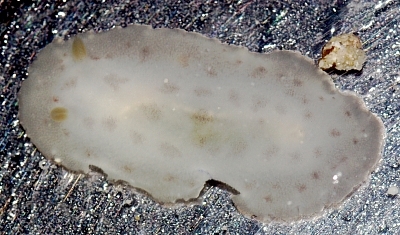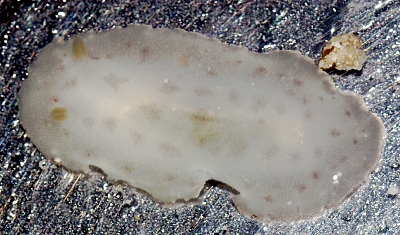
Discodoris mauritiana?
(Bergh, 1889)
Order: NUDIBRANCHIA
Suborder: DORIDINA
Superfamily: EUDORIDOIDEA
Family: Discodorididae
DISTRIBUTION
Tropical Indo-West Pacific
PHOTO
Silhouette Is, Intertidal, Seychelles, Indian Ocean, August 2007, Rock and sand. Length: ~3 cm. Photographer: Richard Barnes.
This dorid appear to be widespread in the Indo-West Pacific but there is still considerable confusion over its identity. Malcolm Edmunds (1971) identified it as Peltodoris mauritiana Bergh, 1889 but he wasn't sure his specimens were all the same or very confident that many of the species named by Bergh and others as Discodoris and Peltodoris were identifiable today. So my identification of this as Discodoris mauritiana is mainly because I have always called it that, rather than from any deep understanding of this groups of greyish, mottled 'flat dorids'.
The mantle is a translucent greyish white with light purplish grey patches often with a darker spot in each patch.
They are a group which need work.
-
Bergh, L. S. R. (1889) Malacologische Untersuchungen. Nudibranchien vom Meere der Insel Mauritius. In: C.G. Semper, Reisen im Archipel der Philippinen, Wissenschaftliche Resultate. Band 2, Heft 16b.: 815-872,Pls.82-84.
-
Edmunds, M (1971): Opisthobranchiate Mollusca from Tanzania (suborder Doridacea). Zoological Journal of the Linnean Society 50(4), 339-396. (Pl.1)
Rudman, W.B., 2007 (August 26) Discodoris mauritiana? (Bergh, 1889). [In] Sea Slug Forum. Australian Museum, Sydney. Available from http://www.seaslugforum.net/find/discmaur
Related messages
Discodoris mauritiana? from Egypt
August 26, 2008
From: Sven Kahlbrock


Hello Bill,
I found this species at our housereef in Hurghada. I just found one picture that seems to be the same spec.there it`s called Jorunna pantherina. Is this possible? The depth was approx. 8 m and it´s size approx. 40mm.
Locality: Housereef, Arabella resort/ Hurghada, 8 m, Egypt, Red sea, 08 april 2008, sand. Length: 40 mm. Photographer: Sven Kahlbrock.
Sven Kahlbrock
s_kahlbrock@web.de
Kahlbrock, S., 2008 (Aug 26) Discodoris mauritiana? from Egypt. [Message in] Sea Slug Forum. Australian Museum, Sydney. Available from http://www.seaslugforum.net/find/21563
Dear Sven,
This is definitely not Jorunna pantherina. Species of Jorunna have special tubercles all over the mantle [caryophyllidia] which have a ring of pointed projecting spicules around the tip. In this animal the tubercles are soft and lack spicules. I am calling this species Discodoris mauritiana, but as I discuss on the Fact Sheet, I am not a 100% sure this is the same animal that Bergh was describing way back in 1889.
Best wishes,
Bill Rudman
Discodoris mauritiana from the Seychelles
August 28, 2007
From: David K A Barnes

Does anyone recognise this, again photo only I'm afraid.
Locality: Silhouette Is, Intertidal, Seychelles, Indian, August 2007, Rock and sand. Length: ~3 cm. Photographer: Richard Barnes.
Richard Barnes
dkab@bas.ac.uk
Barnes D.K.A., 2007 (Aug 28) Discodoris mauritiana from the Seychelles. [Message in] Sea Slug Forum. Australian Museum, Sydney. Available from http://www.seaslugforum.net/find/20539Dear Dave,
This dorid appears to be widespread in the Indo-West Pacific but there is still considerable confusion over its identity. Malcolm Edmunds (1971)identified it as Peltodoris mauritiana Bergh, 1889 but he wasn't sure his specimens were all the same or very confident that many of the species named by Bergh and others as Discodoris and Peltodoris were identifiable today. So my identification of this as Discodoris mauritiana is mainly because I have always called it that, rather than from any deep understanding of this groups of greyish, mottled 'flat dorids'.
They are a group which need work.
-
Bergh, L. S. R. (1889) Malacologische Untersuchungen. Nudibranchien vom Meere der Insel Mauritius. In: C.G. Semper, Reisen im Archipel der Philippinen, Wissenschaftliche Resultate. Band 2, Heft 16b.: 815-872,Pls.82-84.
-
Edmunds, M (1971): Opisthobranchiate Mollusca from Tanzania (suborder Doridacea). Zoological Journal of the Linnean Society 50(4), 339-396. (Pl.1)
Best wishes,
Bill Rudman
